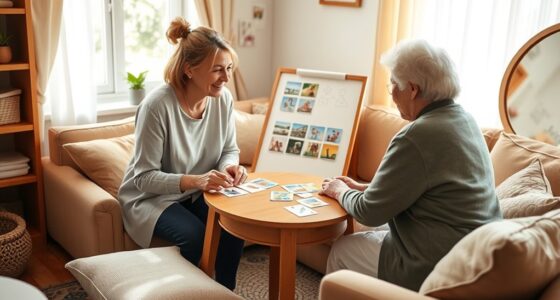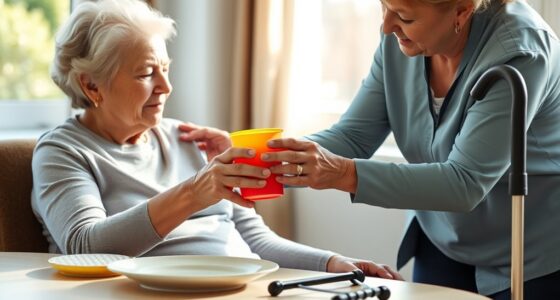Supporting your loved one during stroke rehabilitation at home involves helping them regain independence through therapy, assistive devices, and environmental tweaks. Use properly fitted mobility aids like walkers or canes, and keep the environment safe by removing hazards and adding safety features. Encourage participation in daily activities and celebrate progress to boost their confidence. Combining emotional support with professional guidance helps improve recovery. Stay engaged—you’ll find helpful strategies to aid their journey every step of the way.
Key Takeaways
- Implement personalized routines and environmental modifications to ensure safety and promote independence during recovery.
- Educate on proper use and fitting of assistive devices like walkers and grab bars to prevent falls and boost confidence.
- Offer emotional support by acknowledging feelings, celebrating progress, and encouraging participation in daily activities.
- Collaborate closely with healthcare professionals to follow tailored therapy exercises and safety recommendations.
- Regularly assess and adjust devices and routines to meet evolving needs and maximize functional recovery at home.

Caring for a loved one after a stroke can feel overwhelming, but understanding the rehabilitation process can make it manageable. One of your main roles is to help your loved one regain independence, which often involves using assistive devices like walkers, canes, or grab bars. These tools are designed to support mobility and safety, so becoming familiar with their proper use is essential. As you introduce these devices, ensure they’re correctly fitted and practical for your loved one’s specific needs. Proper placement and instruction can boost confidence and reduce fall risks. Alongside physical aids, emotional support plays a critical role in recovery. A stroke can leave your loved one feeling frustrated, anxious, or depressed, and your encouragement can make a significant difference. Regularly check in on their mood and validate their feelings, reminding them of their progress and strengths. Your empathetic presence can foster resilience and motivation during challenging days.
Rehabilitation at home often involves establishing routines that promote recovery and safety. Break tasks into manageable steps, and be patient as your loved one practices new skills. Consistent encouragement helps build their confidence while preventing frustration. It’s also crucial to adapt the environment to their needs—remove tripping hazards, install handrails, and ensure clear pathways. These modifications support independence and prevent accidents. When assisting with daily activities like dressing, grooming, or eating, use assistive devices as needed, and encourage your loved one to participate actively. This involvement promotes a sense of control and progress, even if it’s gradual. Understanding Retirement Planning strategies can help you manage future financial needs related to healthcare and rehabilitation expenses.
Establish routines, adapt the environment, and involve your loved one in daily tasks to support recovery and independence.
You’ll also need to coordinate with healthcare professionals, such as physical therapists, occupational therapists, or speech-language pathologists. They can recommend specific assistive devices tailored to your loved one’s condition and provide guidance on exercises and techniques to maximize recovery. Following their advice and integrating therapy exercises into daily routines can accelerate progress. Remember, emotional support is just as important as physical assistance. Celebrate small victories to boost morale and remind your loved one that improvement is possible. Be patient during setbacks and stay positive, offering reassurance and understanding.
In this journey, your role extends beyond physical help—your presence, encouragement, and patience are crucial components of the rehabilitation process. By combining practical tools like assistive devices with heartfelt emotional support, you’re creating a nurturing environment that encourages recovery, fosters independence, and helps your loved one regain their confidence after a stroke.
Frequently Asked Questions
How Can I Motivate My Loved One During Recovery?
You can motivate your loved one during recovery by using motivational strategies like setting small, achievable goals and celebrating progress. Offer consistent emotional support, showing empathy and encouragement to boost their confidence. Remind them of their strengths and progress, which helps maintain positivity. Your active involvement, patience, and genuine encouragement make a big difference in keeping their spirits high and motivation strong throughout their rehabilitation journey.
What Are Signs of Depression Post-Stroke?
Think of your loved one’s mind as a garden that needs careful tending. Signs of depression post-stroke include persistent sadness, withdrawal from activities, and changes in sleep or appetite. They may seem emotionally distant or lose interest in things they once enjoyed. Offering emotional support and practicing mental health awareness helps nurture their recovery. Recognizing these signs early allows you to seek professional help, helping their mental health blossom again.
How Do I Manage Medications and Appointments?
You should keep a detailed record of medication schedules and set reminders to make certain your loved one takes their meds on time. Use a pill organizer to simplify daily doses. For appointment coordination, create a shared calendar and double-check upcoming visits. Call ahead to confirm appointments and prepare questions. Staying organized helps prevent missed medications and ensures all healthcare needs are met efficiently.
What Safety Modifications Are Essential at Home?
Of course, you want your home to be a fortress of safety, right? Start with clear pathways for better mobility and install grab bars in bathrooms. Use home safety features like locks and alarms, and keep mobility aids nearby. Don’t forget to remove tripping hazards and ensure good lighting. These simple modifications foster a safer environment, helping your loved one maintain independence and reducing the risk of falls.
How Can I Handle Sudden Behavioral Changes?
When sudden behavioral changes occur, stay calm and provide emotional support to help your loved one feel safe. Use clear communication strategies, like simple language and patience, to understand their needs and reduce frustration. Offer reassurance and listen actively, showing empathy. If behaviors persist or worsen, seek guidance from healthcare professionals to develop effective coping strategies. Your calm presence and consistent emotional support make a significant difference during these challenging moments.
Conclusion
Remember, you’re in this for the long haul, and patience is your best ally. Every small step your loved one takes is a victory worth celebrating. Keep encouraging them and stay consistent with their rehabilitation routine. Challenges will come, but don’t throw in the towel; perseverance is key. With your unwavering support, you’ll help turn setbacks into comebacks. Stay the course—your dedication can make all the difference in their journey to recovery.









